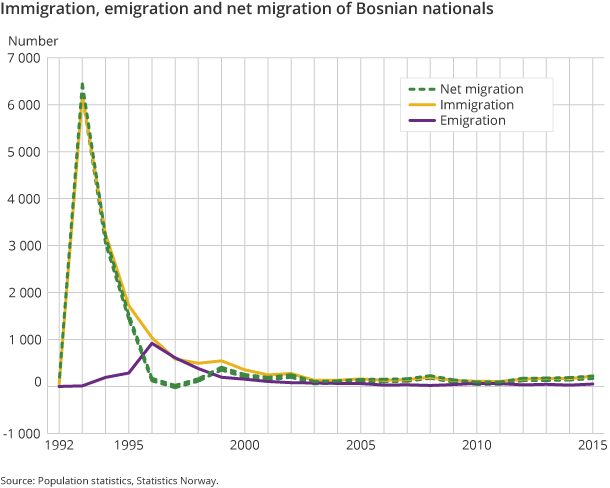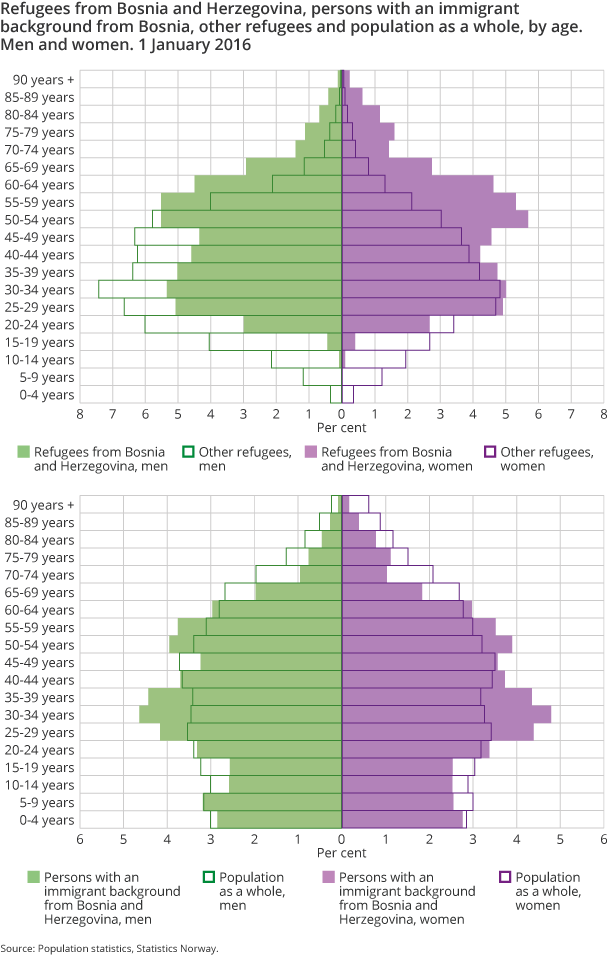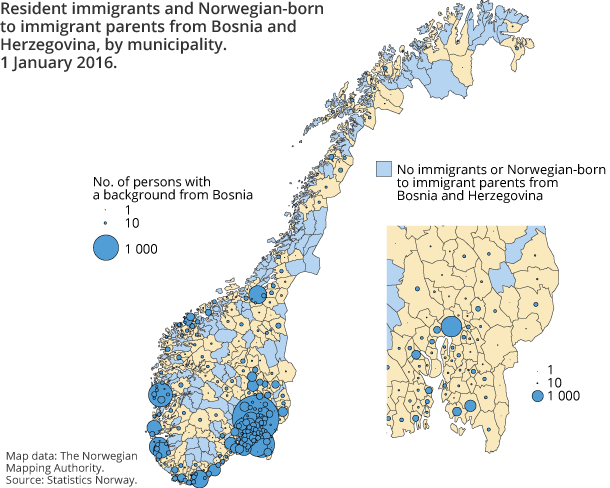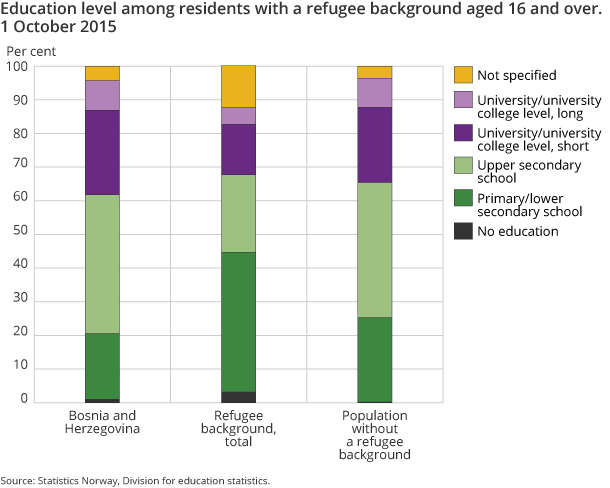Statistical analysis, 2017
Displaced persons from Bosnia and Herzegovina arriving in Norway in the 1990s
Bosnians – the integration champions?
Published:
This article was first published in Norwegian, in Statistics Norway’s journal Samfunnsspeilet: Dzamarija, Minja Tea (2016): På flukt fra Bosnia-Hercegovina til Norge på 1990-tallet. Bosniere – integreringsvinnerne? Samfunnsspeilet 4/2016. Statistisk sentralbyrå.
During the Yugoslav Wars in the 1990s, 14 000 people fled Bosnia and Herzegovina and ended up in Norway. Most of these were families arriving together. The refugees were scattered throughout the country, and few have returned to their homeland since the war ended. Thirty-five per cent of Bosnians in Norway have a higher education, compared with 32 per cent of the Norwegian population in general. Very many Bosnians are also in employment.
- Series archive
- Statistical analysis, 2017
Yugoslavia was a country in the Balkans that was broken up in the early 1990s during a war that was as bloody as it was incomprehensible to most people. The distinctive culture and highly diverse mix of ethnic origins among citizens of Bosnia and Herzegovina meant they were particularly subjected to displacement, violence and destruction in this tragic conflict. A total of two million people were displaced as a result of the war in the former Yugoslav republic.
Three years of conflict
In the aftermath of the Yugoslav Wars that spread to Bosnia and Herzegovina in the first half of 1992, the first group of Bosnian refugees arrived in Norway the same year. The majority, 6 000 persons, came in 1993, and particularly between July and September following Sweden and Denmark’s introduction of a visa requirement for Bosnians in June 1993. 1994 and 1995 also saw relatively large numbers arriving in Norway. The Dayton Peace Agreement of 1995 ended the three and a half-year Bosnian War. The number of Bosnian refugees subsequently dropped substantially every year, ending entirely in 2009.
Most remained in Norway despite original requirement to return
The original basis for accepting Bosnian refugees was that they would return home when the war ended. As early as 1992 it was decided that Bosnians would be granted temporary collective protection, but they were to be sent back to their homeland when conditions improved. Norwegian authorities initiated a number of measures in the mid-1990s to encourage the refugees to return to Bosnia and Herzegovina. In 1996 and 1997, around 1 500 Bosnian citizens emigrated from Norway.
The Bosnian refugees faced great uncertainty during this period regarding their limited stay in Norway. They were also unsure about how the situation in their war-torn homeland would develop. Norwegian authorities adopted what was referred to as a ‘double strategy’, where Bosnians were granted temporary residence, but were still given full access to society’s key arenas. This primarily manifested itself in rapid settlement in the municipalities, Norwegian language training and opportunities to study and work. Peace in Bosnia in 1995 was fragile, and many refugees did not have a home to return to because it was on the ‘wrong side’ of the Dayton Agreement’s peace line. In autumn 1996, Norwegian authorities decided that the Bosnian refugees’ temporary protection would be replaced with a permanent residence permit. Returning to Bosnia would only be on a voluntary basis. The Bosnians thus became a permanent fixture in the Norwegian community.
Demographically similar to the rest of the population
Immigrants from Bosnia and Herzegovina totalled 13 500 at the start of 2016. In addition, 3 900 children have been born in Norway to two Bosnian parents. Most Bosnian immigrants have a refugee background; there is only a small group of less than 2 000 people who immigrated to Norway at a later date for other reasons.
The total number with immigrant background from Bosnia and Herzegovina in Norway is 17 400. This makes them the seventeenth largest group among the country’s 223 different nationality groups.
Bosnians differ in terms of age and gender from many other refugee groups, where it is common for young, single men to act as the vanguard. Many Bosnians arrived as families, which means that their population composition is similar to that of the Norwegian population. There are relatively more older people, and not such a large overrepresentation of children and adolescents among Bosnians. The gender distribution is also roughly the same in all age groups. However, women are overrepresented in the age groups over 65, in the same way as in the Norwegian population in general.
Little family immigration after primary refugee
Most Bosnian refugees came to Norway as primary refugees, and subsequent immigration of family members has been negligible. Statistics Norway’s official statistics on persons with a refugee background show that 10 600 primary refugees from Bosnia and Herzegovina led to around 1 200 family immigrants, which corresponds to 0.11 family members per refugee (Dzamarija and Sandnes 2016). This low figure is due to the fact that most refugees from Bosnia and Herzegovina arrived together with their families.
In the period 2010–2015, the gender distribution among Bosnians who married was roughly equal (Table 1). More than half found a spouse who already lived in Norway. Around 20 per cent of these women and 11 per cent of the men married a non-immigrant.
Bosnians residing in 278 municipalities
Bosnians are relatively well dispersed throughout Norway, and are found in 278 of the country's 428 municipalities, as shown in Figure 3. The settlement pattern of people with an immigrant background from Bosnia and Herzegovina reflects two important aspects.
Settled quickly and scattered
The vast majority of refugees are allocated a municipality by the central government. In connection with the large settlement of Bosnian refugees in the 1990s, all municipalities were encouraged to accommodate them. They were settled quickly, and most who came to Norway in the period 1992–1993 were allocated a municipality as early as 1994. The official statistics from 1 January 1995 show that the municipalities’ response was good, with all 248 of the country's then 435 municipalities taking in Bosnians.
The principle of scattered settlement of refugees has gradually become an overarching political objective aimed at preventing the development of phenomena that are barriers to integration, such as social, ethnic and economic segregation or the formation of parallel societies.
Staying put
The other important aspect is that, since being given somewhere to live, Bosnians as a group have moved around Norway less than other refugee groups, and fewer have moved to Oslo. Nineteen per cent of Bosnians live in the capital, which of the five largest refugee groups is the second smallest share after Eritreans.
The largest number with an immigrant background from Bosnia and Herzegovina live in Oslo, with a total of 3 400. These constitute 0.5 per cent of the population of the capital city. This is followed by Sarpsborg, Bergen, Drammen and Fredrikstad, each with over 600 people with a Bosnian background. The highest concentration is found in Sarpsborg, where Bosnians make up 2 per cent of the total population of the municipality.
One-third have a higher education
The largest share of Bosnians with a refugee background have an upper secondary education (Figure 4). Bosnians stand out from the average refugee in that they have a much larger share with both an upper secondary education and a higher education. A comparison with the entire refugee group in Norway shows that the share of Bosnians with an upper secondary education is 18 percentage points higher than for other refugees. For education at university and university college level, the disparity is 14 percentage points. Meanwhile, the share of Bosnians with an education at university level is somewhat greater than for the Norwegian population as a whole, with 35 and 32 per cent respectively.
High education participation rate
The figures for participation in higher education show high levels of activity in the education arena for the group Norwegian-born to immigrants from Bosnia and Herzegovina.
Of all Norwegian-born men with a Bosnian background aged 19–24, 42 per cent were in higher education in 2015. Thus, this group’s tendency to study far surpasses that of the population as a whole (Table 2). The figure for Norwegian-born women with a Bosnian background is even higher, with an impressive 59 per cent in higher education.
High rate of employment and ‘only’ 4 per cent unemployment
The national employment rate in the fourth quarter of 2015 was 66 per cent. The corresponding share for Bosnians was 65 per cent. This means that the employment rate among Bosnians is…
…roughly on a par with the population as a Whole
...somewhat lower than the population without an immigrant background
…higher than for immigrants as a Whole
…well above average for immigrants from Africa and Asia – where most of the other refugee groups are from.
These disparities can be clearly seen in Table 3.
In the second quarter of 2016, the share from Bosnia and Herzegovina registered as fully unemployed and participants on employment initiatives was 3.7 per cent. For the population as a whole, registered unemployment was slightly lower, at 2.5 per cent. Bosnians have a lower registered unemployment rate than immigrants as a whole, who have 6 per cent. Among the ten largest refugee groups, they also have the lowest unemployment (Table 4).
The low unemployment among Bosnian women is particularly worth a mention. Their unemployment was…
…somewhat higher than for women as a Whole
…slightly lower than for Bosnian men
…markedly lower than for other female immigrants.
The employment rate for Bosnian women is also on a par with the rate for women as a whole in the population.
Successful integration?
Integration is a key element of Norway’s immigration and refugee policy, but it is a broad term that is not easy to define. In the public discourse on immigrants and refugees, the term has many different meanings. There are some general indicators that help to determine the degree or lack of integration. Participation in education and employment are examples of good integration indicators that we can produce using statistics, and that are frequently used by authorities to design a good integration policy.
Bosnians score high in these key integration indicators. Bosnian immigrants and their Norwegian-born children are highly visible in the education system, which is a foundation for further participation in society. The same applies to working life, where Bosnian women and men both participate actively and to the same extent. In several other large refugee groups, we see clear gender disparities related to labour participation. This may be because the Bosnians’ attitudes to education and employment are traditionally more aligned with the Nordic people than is the case for many other refugee groups. They came from a socialist society where the concept of equality was strong, and where women actively participated in society.
According to these indicators, the Bosnian's adaptation to a new society can be considered a success. However, there are other indicators within the field of integration that are also regarded as crucial to ‘successful integration’. This data is more difficult to obtain, measure and operationalise, but is undoubtedly of great significance. We refer to indicators such as…
…feeling at home in Norway
…being part of the local community
…having Norwegian friends
…taking an interest in society and planning to remain in Norway.
Some of this can be examined using measurable indicators, such as the transition to Norwegian citizenship. Changing citizenship can be a difficult and emotional choice, but most Bosnians in Norway have done it. As of 1 January 2016, three out of four Bosnians had Norwegian citizenship, which may indicate a strong sense of belonging to Norway and an intention to remain here.
The settlement pattern of Bosnians shows that this group is more settled than many other immigrant groups, which may suggest that they are well embedded in their local communities.
When Bosnians came to Norway, the authorities tried to implement what was called a ‘two-track race’, i.e. integration in a return perspective (Haagensen 1999). Although they were granted temporary protection with the aim of eventually returning to Bosnia and Herzegovina, the refugees were not left to linger in reception centres, isolated from the rest of society. Instead, they were quickly housed in the municipalities, with access to all major social arenas. This process is often referred to by the media as a national effort characterised by solidarity, empathy and enthusiasm, where ‘everyone’ contributed – the Norwegian people, the local authorities and the central government.
The statistics confirm that some good decisions were made by the authorities by quickly including this group in society through access to education and employment. Concepts such as ‘everyday integration’, social contact and the feeling of being included and belonging somewhere are more difficult to measure, but when the Bosnians in Norway celebrated twenty years of their arrival in Norway, the words of the Bosnia and Herzegovina society in Norway suggested a strong sense of belonging, respect and, not least, gratitude:
“We would like to take the opportunity on our twentieth anniversary, to stop, look back on our history, pay tribute to the Norwegian people’s major humanitarian effort, which helped us when it really mattered, and show the Norwegian people that we deeply appreciate all the help we have received. We are immensely grateful. We are also proud and pleased to be able to repay this help through our participation in and contribution to Norwegian society.” (Bosnia-Hercegovina Forbundet i Norge, 2013).
References
Dzamarija, M. T. & Sandnes, T. (2016). Familie¬ innvandring og ekteskapsmønster 1990¬2015 (Reports 2016/39.). Oslo: Statistics Norway.
Henriksen, K. (2007). Fakta om 18 innvandrergrupper i Norge (Reports 2007/29). Retrieved from https://www.ssb.no/a/publikasjoner/pdf/ rapp_200729/rapp_200729.pdf
Haagensen, E. (Red.). (1999). Midlertidig beskyttelse og tilbakevending: Bosniske flyktninger i Norden. Copenhagen: The Nordic Council of Ministers.
Mønnesland. S. (1999). Før Jugoslavia og etter. Oslo: Sypress Forlag.
Utrop (22.05.2013).
Contact
-
Statistics Norway's Information Centre




